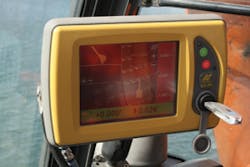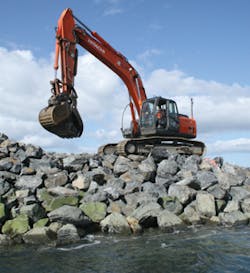For Pacific Pile & Marine, a marine contractor involved in a major waterfront cleanup project, the advantages were immediate and numerous: a savings in time, a better degree of accuracy, and a greatly reduced risk factor. From an economic standpoint, the Seattle-based company says it didn’t fare too badly either: The company anticipates that its Topcon X63 3D machine-control system will have paid for itself in savings by completion of its first project. Nothing rocky about that at all.
Gone but not Forgotten
Situated on Fidalgo Bay, the Port of Anacortes is a picturesque town in northwestern Washington state that, up until the late 1970s, was home to a pulp mill owned and operated by the Scott Paper Co. After shutdown and demolition, several other businesses operated at that location until 2000, when contaminated soil was discovered onsite. A period of investigation, further testing, and litigation ensued until an agreement for cleanup was reached between state and federal environmental officials and Kimberly-Clark, which had purchased Scott Paper. According to Greg Anderes, project manager for Pacific Pile & Marine (PPM), the general contractor in charge of the $12 million cleanup, the project actually consists of a number of facets.
“In its most basic sense, this is a shoreline cleanup,” he says, “but it is really a lot more than that. The pulp mill had piers that used to extend out into the water; when they collapsed they were left to settle into the water. So, for the first 100 feet or so, from mean high water up to the shore, we are dredging that material out to a depth of about 3 feet and placing a natural cap over it to restore the bottom.”
The cap to which Anderes refers is a combination of different materials ranging from angular rock to sand and gravel mix. It is placed in one of two ways. Some of it is trucked in and dumped, then moved and placed using a Hitachi Zaxis 270 excavator. “The majority of it, however, is done using a larger machine, a Hitachi EX 1200,” he says. “That material is generally barged in and taken from the barge and placed. When complete, any material not removed will be covered up and the sea bottom will be clean and fairly smooth.”
Motion of the Ocean
Because the waters in that part of Fidalgo Bay can get very choppy in rough weather, construction of a pair of breakwaters (“wave attenuators” in project-speak), was also designed into the project. An existing wooden breakwater is not only outdated and in need of replacement, it is essentially nonfunctional, according to Anderes.
“Waves just bounce off that existing structure and erode the beach,” he says. “If that were to continue, it would peel off the cap we are installing and expose the material lying below. So a pair of totally new attenuators-one 600 feet long, and a second one that will be 400 feet in length-is being built to protect the work we are doing.”
The papermill cleanup project was bid with the use of traditional surveying techniques in mind. For PPM, says Anderes, that meant having a grade person out on the rocks with a backpack GPS unit.
“Traditionally, that worker would set some stakes or establish paint marks to let the operator know what the grades were, and where to be able to go and work,” he says. “It’s not the best environment to be working in. Our low tides are often at night and it’s a steep 1.5:1 slope with huge rocks that are somewhat unstable because they have not been not keyed in yet. So, essentially, you have a man out there climbing around the rocks-on the water-with an expensive GPS unit, and an operator who can’t always see him. We quickly saw that was going to be a problem.”
Rock-Solid Control
Even at the start of the project in September, 2009, PPM already had a decent level of experience with GPS. The company had previously outfitted its Hitachi 1200 with a self-built system running both “Dredge Pack,” a marine positioning and mapping software package, and “Hypack” which allows for creation of contour drawings, cross-section views, and volume computations to aid in the dredging operation. The company wanted a similar but far better level of control for its smaller excavator, which would be directly involved in the upper portion of the breakwater construction, so it turned to PPI Group, the area Topcon dealer, for help.
“We already owned a Topcon total station and liked it for its ease of use and durability, two things which we definitely needed on this job,” says Anderes. “I contacted Collin McCoy, PPI Group’s sales manager, and, after discussing our needs, he recommended a Topcon X63 3D system, which he said they could get to us in two weeks. In equipment supply, that generally means four to six weeks, but two weeks later it was being mounted on the Hitachi 270.”
Despite assurances from McCoy that the Topcon system would be extremely user friendly, Anderes says he was apprehensive about how much of a learning curve there would be with the new system. “I was worried that we will have spent a decent amount of money and would not have had the system dialed in until the end of the job-if ever. That’s been the case with some of our older equipment. But I couldn’t have been more wrong; only hours after installation our operator was using it and raving about it.”
On the Attenuator
Each of the breakwaters measures 80 feet at the base and narrows to 5 feet at the top. The slope is 2:1 down the side facing shore and 1.5:1 on the backside face; both sides slope up to a 5-foot-wide flat top. The materials at Anacortes include a bedding material, which is a blend of 8-inch-minus angular rock; a core material, which is a beach-ball-size rock; and an armor rock which is a 4- to 6-foot layer of boulders (some as large as 2,500 pounds) placed on the outside. When complete, PPM will have moved and placed better than 50,000 tons of rock for the two structures.
Because the company actually bid the project-and started it-using conventional surveying and machine-placement techniques, the impact of machine control was immediate. According to Zach Martin, PPM’s surveyor, in addition to the hazards mentioned earlier, the previous method was extremely cumbersome.
“Before we got machine control on the 270, I would be out here on the rocks, communicating with Corey [Woodley, PPM’s operator] using radios and spot checking things along the way. If I did a shot and found an area that needed to come up by 2 feet, I would tell him and he would try to get a 2-foot rock to place there. It was very time-consuming. Now, with the machine control on the 270, Corey knows at all times right where grade is, right where he’s supposed to be.”
An added benefit, says Martin, is the system’s ability to provide instant as-built shots. “Corey simply places the bucket on the rock that he just set, gets those coordinates and downloads them. That frees up both one man and one piece of GPS equipment that can now be used somewhere else. That’s a big efficiency boost for us.”
Off the Wall Production
While they bought the system specifically for work on the attenuators, PPM’s machine control capability is providing benefits on other parts of the project as well, benefits they hadn’t foreseen.
“When we started to do the upland dredging, we were able to load the template from the EX1200 onto the smaller machine, the 270,” says operator Woodley. “Because that file contained dredge grade, cap grade, and so on, we could rake the dredge cut into a pile at low tide, while we could see it. Then, at high tide, we were able to float in with the dredge rig, load that material onto the barge, and take it away. That ability to work in either high or low tide really increased our overall productivity. In addition, GeoEngineers, the firm that constructed all of our models, was able to link data from the 270 into a web based map viewer for use by the Port’s construction management and inspection team-a benefit for them.”
By project’s end, PPM will have hauled out about 50,000 cubic yards of contaminated material. Half of that is being taken to DNR-approved open-water disposal sites and half to a landfill in eastern Washington. Andres says when complete, the area will once again be pristine and usable by area residents.
“Before we started, this site was pretty ugly-a lot of debris in the water. It’s a bit of a pain for the locals to deal with now but when it is restored it will be nicer than it has been for decades. And the fact that we have been able to be so much more efficient with the new machine-control system has helped keep us on track toward making that happen. Based on what we have been able to do with the Topcon system, I have no doubt that it will have paid for itself just on gains we’ve made here at Anacortes. And I see it playing a nice role in future projects as well-we couldn’t be happier.”




